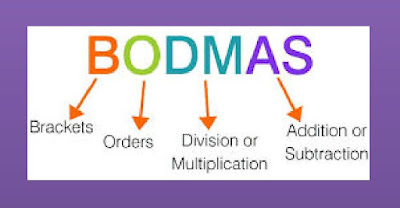Lesson Plan of Order of Operation: BOD-MAS Rule
Lesson Planning of Order of Operation: BOD-MAS Rule
Subject Mathematics
Grade 5th
Students` Learning Outcomes
- Recognize BOD-MAS rule, using only parentheses ( ).
- Carry out combined operation using BOD-MAS rules.
Information for Teachers
B Bracket first
O Orders (i.e. Powers and Square Roots, etc)
D Division and
M Multiplication
A, Addition
S Subtraction
- Parentheses are used in math to show a part of math expression or equation that must be solved first, before any other calculation are done.
- In this lesson we will use only parenthesis ( ) as brackets.
- While teaching the lesson, also teacher consult with textbook at all steps wherein and whenever applicable.
Material / Resources
Writing board, chalk / marker, duster,
textbook
Introduction
- Introduce to the students that Math operations tell whether to add, subtract, multiply or divide, and parenthesis tell which operation is to be done first.
Write 3 + 2 x 4 = ------------- on board.
Write 20 as answer and ask who is agreeing?
Write 11 as answer and ask who agrees or disagree?
What are we to do – how can there be two answers in Math?
Explain the rule that we do multiplication first, addition second.
Ask can I make 3 + 2 x 4 = 20? (True)
- Tell the students that we follow the order like;
- 1.
B
brackets first
- 2.
O
Orders (Powers and square roots etc.)
- 3.
D
Division
- 4.
M
Multiplication
- 5.
A
Addition
- 6.
S
Subtraction
- Explain to the students that;
- Parenthesis ( ), can be used in math to show which part of the math expression should be done first, i.e. 8 – 5 + 1 and 8 – (5 + 1). The only difference between these two expressions is the parentheses.
- Operation given in parenthesis should be solved first.
Development
Activity 1
- Tell the students that we do operation on numbers. We add, subtract, multiply divide, but what to do if we have more than one operation to do at a time?
- How do we solve this: 3 – 5 ÷ (1 + 4) =?
- Let`s put BOD-MAS into practice.
- Repeat the acronym with whole class i.e. ( ), of, ÷, x +, -.
- Write the following examples on the board and solve with the help of the students.
- Write first example on the board refers to the BOD-MAS rule and ask;
o Do we have any (parenthesis) [no]
o Do we have any order or powers? [no]
o What to do first addition or division? [division]
- Similarly discuss all the examples on board with students.
- Write on the board and explaining (8 – 4) + 5 x 8
- Parenthesis come first, so 8 – 4 = 4.
- Replace in the expression with 4, where (8 – 4) was, so: 4 + 5 x 8.
- This contains addition and multiplication. Multiplication comes before addition, so 5 x 8 = 40. Replace 40 with 5 x 8 in the sentence.
- That leaves 4 + 40. Finally, add 4 + 40 = 44. Solve few more same examples on the board with the help of the students.
- Divide class in groups of four and distribute mathematical sentences written on paper pieces. Each group will get the required result by applying brackets, e.g.
- Groups will swap their sheets after completing for the peer checking.
Activity 3
- Divide class into pairs
- Write numbers from 2-9 on paper slips fold them and put them in a box.
- Ask each pair to take one paper slip.
- Give them instruction that they have to use the number and operations to get the answer equal to 1.
- For example if they have got 4, they have to use 4 four times and get answer equal to 1 like ;( 4 ÷ 4) + 4 – 4 = 1
- Similarly find an expression to make the number equal to 0.
- Time the activity.
- If students don`t get the answers. Solve on the board with the help of the students.
- This will give them extensive practice with application of BOD-MAS.
Sum up / Conclusion
- Parentheses are used to show what should be done first in arithmetic expression.
- Parenthesis () are the most frequently used group symbols.
Assessment
- Give the following questions to solve individually.
Follow up
Make 5 different arithmetical expressions using all operations and parenthesis, giving answer equal to 5 for each expression.











Comments
Post a Comment